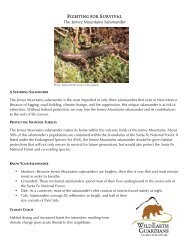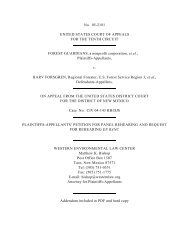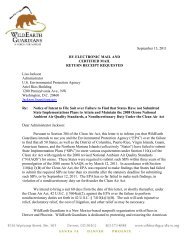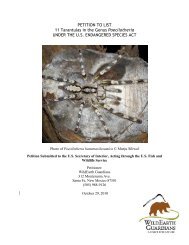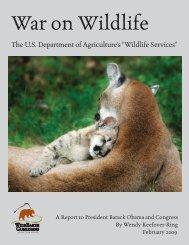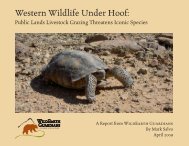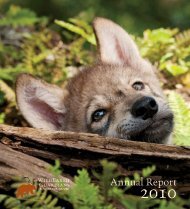PETITION TO LIST THE JEMEZ MOUNTAINS SALAMANDER ...
PETITION TO LIST THE JEMEZ MOUNTAINS SALAMANDER ...
PETITION TO LIST THE JEMEZ MOUNTAINS SALAMANDER ...
Create successful ePaper yourself
Turn your PDF publications into a flip-book with our unique Google optimized e-Paper software.
WildEarth Guardians Petition to List<br />
Jemez Mountains Salamander Under the ESA<br />
15<br />
Table 2. Estimated population size and population statistics for Jemez Mountains<br />
salamanders on DOME SLOPE and POSOS Activity Plots from 1997-2000.<br />
Population size was estimated using the Peterson method (Seber 1982, cited in NMDGF<br />
2000c). Each Activity Plot is 2500 m 2 or ! hectare (NMDGF 2000c).<br />
Activity Plot<br />
Year<br />
Population<br />
Estimate on<br />
Activity Plot<br />
Population<br />
estimate per<br />
hecatare (per<br />
acre)<br />
Standard<br />
Error<br />
(Population<br />
Estimate)<br />
Lower 95%<br />
Confidence<br />
Interval<br />
Upper 95%<br />
Confidence<br />
Interval<br />
DOME SLOPE<br />
1997 94.3 377 (153) 20.8 52.8 135.9<br />
1998 101 404 (164) 25.2 50.5 151.5<br />
1999 32.3 129 (52) 8.6 15 49.5<br />
2000 63 252 (102) 21.5 20.1 105.9<br />
POSOS<br />
1997 121.4 485 (197) 39.2 43 199.8<br />
1998 91.5 366 (148) 30.3 31 152<br />
1999 69 267 (112) 25.1 18.8 119.2<br />
2000 26.4 106 (43) 4.7 17 35.8<br />
Of note is that collection of salamanders, especially at the type locality, may drastically<br />
impact survey findings as well as lead to localization extinction of the species.<br />
Demography and Reproduction<br />
Sexually mature males average 55.2 mm SVL, while sexually mature females average<br />
56.2 mm SVL (Degenhardt et al. 1996). Females reach sexual maturity around three<br />
years of age and lay eggs every other year (Behler and King 1979). Through examination<br />
of gonads it was determined that individuals under 50 mm SVL are juveniles (Brodie and<br />
Altig 1967).<br />
Extensive research on the reproduction of P. neomexicanus was conducted by Williams<br />
(1976, 1978). The following information is taken from these studies. Based on ova<br />
diameter, two reproductive classes of P. neomexicanus are discernable. In Class I,<br />
females do not lay eggs during the current summer. These females average 7.7 maturing<br />
eggs with about four in each ovary. In Class II, females are considered gravid. They<br />
mate and oviposit their eggs by the beginning of the next active season (June –<br />
September). The number of maturing eggs average 7.8, with equal numbers in each<br />
ovary. It is believed, but has not been demonstrated, that a third class of females may be<br />
present. These individuals are presumed to be underground with their egg clutches.<br />
They move into Class I during the next summer.<br />
Males begin spermatogenesis during late fall with the formation of secondary<br />
spermatogonia. Differentiation to primary spermatogonia begins in early June and<br />
continues through August. Spermatids are formed from mid-July to mid-September and<br />
spermatozoa form in late August. The entire testes are full by early fall.



